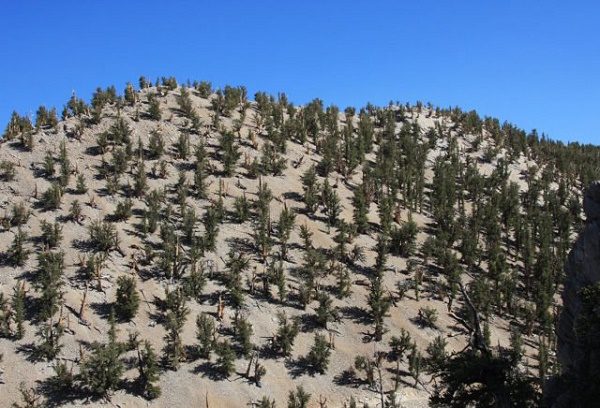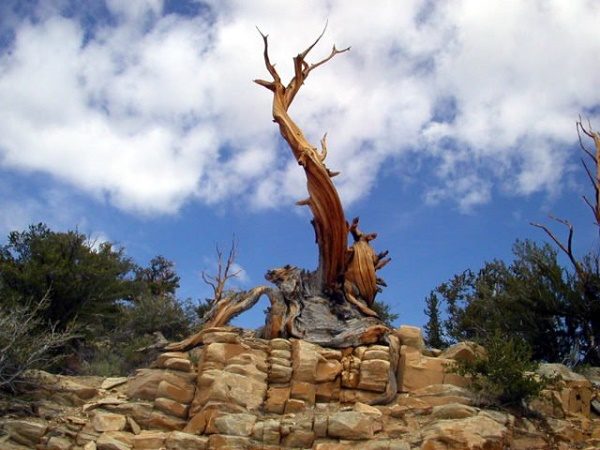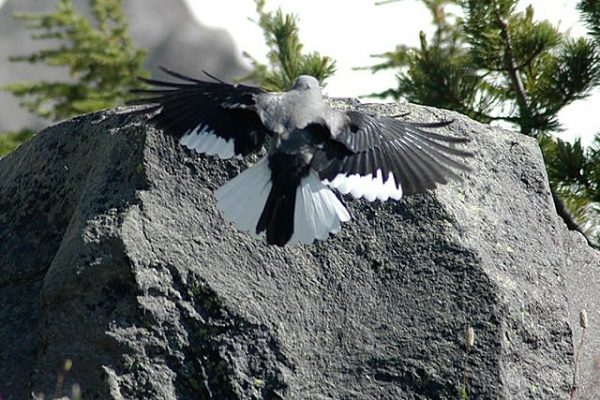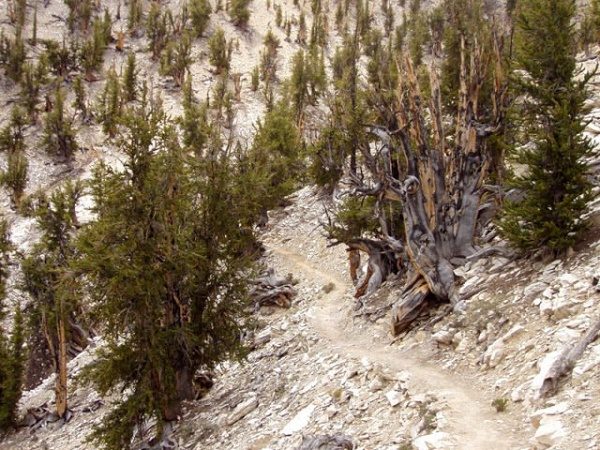Hidden in the mountains of California, Nevada, and Utah, lurk some of the oldest known long-living species of the Great Basin bristlecone pine, or
Pinus longaeva. One member of this species, noted to be 5066 years old, is considered the oldest known living organism on Earth. The ancient tree can be found in the White Mountains in California, but its exact location is kept secret. The tree was cored by specialist Edmund Shulman, dedicated researcher and explorer of long-lived trees, and its age was determined by Tom Harlan.
The age of the tree means that it was alive while Stonehenge was under construction and around the time when the first writing system was invented in Sumeria.
Dating from the Bronze Age, the Great Basin bristlecone pine belongs to a species that does not grow taller than 15 meters, and its trunk does not extend in diameter more than 3.6 meters. These ancient trees have knotted and gnarled appearance, especially those growing at higher altitudes. They also have reddish-brown bark with deep fissures.
The Great Basin bristlecone pine differentiates from the Rocky Mountain bristlecone pine in its needles; the first always have a pair of unceasing resin canals, and so lack the emblematic small white resin flecks of the second. Unique too are its cones that are more rounded compared to the more pointed ones of the other species.

A large specimen of the tree, showing both live and dead sections and streaked grain colors on its broad trunk. Location: the Ancient Bristlecone Pine Forest, White Mountains, California
In California, Pinus longaeva is limited to the White Mountains, the Inyo Mountains, and the Panamint Range, on the territory of the Mono and Inyo counties. In Nevada, it is to be found in the highest ranges of the Basin and Range from the Spring Mountains near Las Vegas north to the Ruby Mountains. In Utah, it grows northeast to south in the Wasatch Range.
The Ancient Bristlecone Pine Forest situated at the White Mountains is one of the best protected areas for this ancient tree.
The growing pattern of the Bristlecones spread out on dolomite hillside, Ancient Bristlecone Pine Forest
Large open terrains are perfect for this type of tree. The species is further unique because it does not form dense forests or closed canopies.
It shares habitat with a number of other types of pines and it does not thrive well in good soils, but rather prefers harsh terrain. Therefore, it is dominant when in high-elevation dolomite soils, where only a few other plants are able to grow.
It does look ancient! Another one at the White Mountains, California
November 1953 was the month when a 2,330 acre swath of bristlecone forest in the Inyo National Forest was declared a protected area. As this helped increasing awareness of the area, it is thanks to Edmund Schulman's discovery of more than
twenty 4,000-year-old trees and the publication about in them the
National Geographic in 1958 that ignited a broader interest of these authentic trees. As of 1987, the bristlecone pine was designated as one of Nevada's state trees as well.

Clark’s nutcracker use the seeds of “Pine longaeva” as a food resource; they also store seeds in the ground, many of which are never used so they are able to grow and emerge as new plants
Edmund Shulman's research and work are pioneering in many terms when it comes to these trees, but as it has been summarized by Donald McGraw on Shulman's real value to the species: "Not that they were 'record' trees, not that they displaced the sequoias in longevity, not that they were extraordinarily beautiful in their appearance, not even that he was the most important discoverer of this fact of their age, but rather that they could do what he cared most about:
function as the best proxies for Earth's climatic history."
The Methuselah Grove trail in the Ancient Bristlecone Pine Forest









Reader Comments
There are still people whom believe that civilization started 6000 yrs ago. This kind of narrow religous thought will ensure that we will never progress as a species.
R.C.
You are correct.
Now some decent Christian member of the National Rifle Association will go to California, search out this tree, and shoot it with lead from his big gun until it falls over dead. Then he can boast to all his friends that he shot the oldest living thing on Earth.
Advice to that man: Once you've shot the tree, you can sell it for an immense fortune to some Chinese tycoon for medicine to cure his erectile dysfunction.
Obviously you know little to zip about firearms, as is your right.
The NRA does NOT represent firearm owners - it represents its agenda, just like the ACLU and WikiLeaks. They all hit their limits where their alleged inviolable truths become 'negotiable.'
For the ACLU, it was when, during the Rodney King crap was going on (a daily occurrence now and long has been - it's just that videos were far rarer then.) For that duration, they officially abandoned (retracted/placed under study) one of the very reason they were formed: the prevention of double jeopardy prosecutions (first via States, second via Feds; ) Why? Political exigencies - they didn't wish to lose black support.
For the NRA the push came to shove when the town in Nebraska? OK? ND? SD? got destroyed by a tornado. The Feds proceeded to go to even completely undamaged and unlooted homes (the only looting was being done by the gov. flunkies) who were breaking into home, searching for guns, opening gun safes and stealing all their firearms - (mostly deer rifles). Complaints to Congress AND the NRA went nowhere/ were completely ignored. When they finally got their guns back, they were left out in the rain the the owners were lackadaisically slowly told about it while their theretofore completely safe firearms suffered irreprable damage.
For Wikileaks, it seems that for them, though they can provide info that's often been previously leaked/revealed, (e.g., like snowden, when all that was released and divulged long earlier than snowden by Binney, who himself was likely, too, a limited hangout or part of a war between the NSA and the CIA.) Likewise, see how Wikileaks (1) won't touch israel; and (2) has some shady funding... do I smell the stench of the CIA/Ford Foundation behind the statements in this article at Global Research? 'Who is Behind Wikileaks?' at [Link]
So if you trust our/any government, which the above efforts do not even touch on all the evil it now does as a matter of daily wet worki (see, e.g., Gary Webb), like that to be the sole possessor of all firearms in a country; well, if you think what you've seen so far is bad, you've no idea how nazified this country would have long ago easily been made into.
Those who are truly individual rights folks have no effective representation. But their presence makes a difference in retarding the authoritarian measures that will soon end freedom in this once best of nations.
And while I used to think such would not occur nearly so soon, I bet you will see a time where you have a choice to be a snitch pointing out who owns guns, or being protected by someone who does. From your thoroughly illogical and sniveling uninformed statement, I'm confident you'll gladly be the former. But when they come for you . . .
R.C.